Whether you’re a parent or a freshly moved-in college student, that drop-off day is an emotionally charged, chaotic whirlwind of a time. You’re double-checking that everything made it to the dorm and no essential items were forgotten about (like that coveted mini-fridge), all required books are bought, everything’s organized so that it all fits in the teeny tiny space, tears are held at bay until the car pulls away, and that there’s no mold. Wait… come to think of it… You probably didn’t stop to think about mold in college dorms.
And you’re not alone!
You trust the campus either with your safety or your child’s safety, so obviously, that means they actively took steps to prevent mold or handled any moldy situations that popped up, right?!
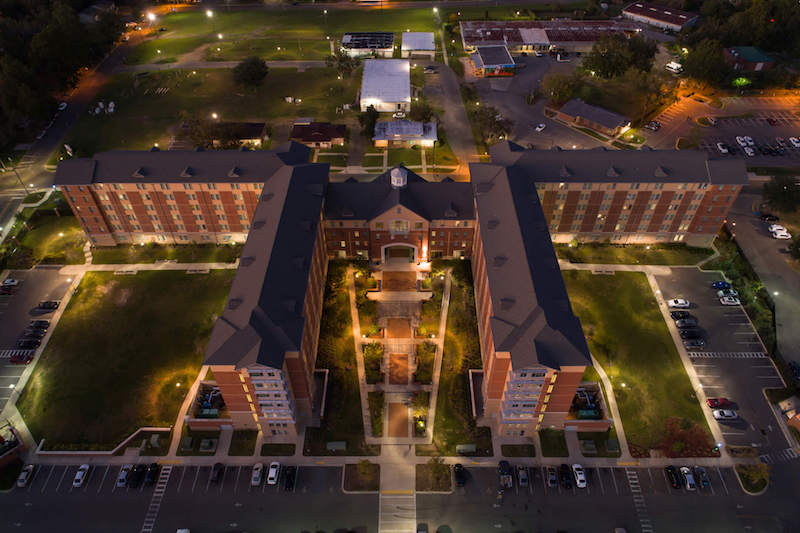
Ehhh, not always. As you’ve probably seen in the news recently and over the years, most universities end up having issues with mold in college dorms. Why is that…?
Well, for starters, these buildings are the perfect storm for prime moldy real estate. Maintaining a robust mold awareness and understanding how it can happen in these areas can help in a number of ways. Including, knowing what to keep an eye out for, expecting certain actions and protocols if mold is found in the dorm, and preventative steps to stop it from growing in the first place.
That way, you or your child can remain safe and healthy while grinding away to get that degree!
So What Is Mold?
To know what to look for and how to prevent it, you’ll need a solid understanding of what mold is in the first place.
Mold is a type of fungus with over 100,000 species identified so far.¹’² It reproduces asexually by creating microscopic spores that it releases into the air. Similar to how a weed produces seeds.
If you dig into the information online, you’ll probably find a lot of comments saying that mold is "ubiquitous." With so many species, and a spore’s ability to scoot along anywhere, mold and spores are pretty much everywhere! Which is fine when it’s outside. These little fungi absolutely play an important part in nature by helping decompose dead material.
Problems begin when this colonized mold growth occurs inside.
Once mold begins to colonize an area, it starts to release more and more spores into the air, which drastically affects the indoor air quality. All of those spores are floating around the indoor space, being inhaled by anyone in the building, and landing on any surfaces they come in contact with. If that surface has the right ingredients necessary for life, they’ll settle in and begin to grow, starting the cycle all over again. Except for this time, there are two mold colonies pumping spores into the air. Yikes.
What constitutes a habitable environment? This hardy fungus only needs four main components to live, most of which are readily available in places like college dorms.³

These components are:
- Oxygen (it requires very little)
- Temperature (most enjoy a balmy 40-90 degrees Fahrenheit)
- Food (like raccoons, they eat almost anything)
- Moisture
That last one is the real kicker in the equation. Since the other three components are easily accessible, all the mold spore really needs as it floats on its merry way is a little patch of damp or wet space and in 24-48 hours, boom, there’s now living mold in college dorms.
And, when mold decides to end up in these spaces, it can put a serious health damper on what’s supposed to be a fun-filled (although seriously stressful) year at school.
Mold and College Students' (or anyone’s) Health
We often see "black mold" splashed across the news and how detrimental it can be to our health. Toxic molds absolutely can cause a long list of adverse health reactions, but indoor mold growth, in general, can also trigger some serious symptoms. Some molds even have the ability to create microscopic toxins, called mycotoxins, that they release into the air right along with those spores.⁴
Researchers are still hard at work attempting to determine exactly how mold can affect our health, but it’s a tough subject to nail down. With so many species and factors like genetics, compromised immune systems, and developing immune systems playing a role, it’s difficult to determine exactly how mold exposure will affect someone’s health.
What we do know is that the body considers foreign particles in the body (like inhaled mold spores) as public enemy number one and will ramp up its immune system to fight off the invaders. Some individuals’ bodies are better equipped to handle the problem and will experience little to no symptoms. Others will quickly develop a laundry list of potential symptoms ranging from mild to severe. Those with preexisting conditions and compromised immune systems are among those more prone to mold exposure symptoms. ⁵’⁶’⁷

These symptoms can include (but are not limited to):
- Coughing
- Runny Nose
- Watery Eyes
- Chronic Fatigue
- Brain Fog
- Mood swings
- Neurological Issues
- Digestive Issues
- Respiratory Problems
Not exactly the college experience that students and parents expect. After all, you should be worried about passing classes and making life-long friendships, not bogged down by a persistent mold-induced sickness. Especially from things like brain fog and chronic fatigue, which can seriously impact academic performance.
All of which is probably why the EPA recommends removing mold growth when it’s found and a section specifically dedicated to schools and commercial buildings. Regardless of if the species of mold is toxic, you never know how you or your child will be affected by this fungus. ⁸
That’s why more awareness needs to be brought to mold in college dorms, what to do if it’s there, and how to actively prevent it from growing in the first place.
Why There’s Mold in College Dorms
There’s no getting around it, most dorms are pretty gross. Not to mention the age of many of these buildings, how they were constructed, and the potential for improper maintenance, all of which happen to create ripe conditions for mold growth.
Over the years, many universities have found themselves in the news over serious problems with mold in college dorms.
-Students at Howard University in Washington, D.C. staged protests over moldy dorm rooms and the lack of action taken to remove the problem.⁹
-Mold was discovered in the HVAC units of two dorms at Dartmouth University, leading them to move the students out of the problematic areas.¹⁰
-Between August and October of 2018, Georgetown University received over 350 notices of mold growth in dorm residences.¹¹
-The College of William and Mary has experienced multiple, ongoing mold issues over the years in dorms and classrooms.¹²
-The University of Maryland moved over 500 students out of a dorm and into hotels.¹³
The list goes on. Chances are, if you Google any college and "mold," you’ll probably find a list of stories detailing problems they’ve experienced. Not only that, lawsuits are similarly increasing as students and parents seek reparations for their experience in moldy dorm rooms and the harm it caused to their health.
One family is suing the University of Maryland’s College Park campus after their daughter with a pre-existing health condition perished after a mold-related incident combined with an interaction with the adenovirus.¹⁴ They claimed that the campus did far less than it should to handle the mold problem and the spread of the virus, which ultimately led to her death.
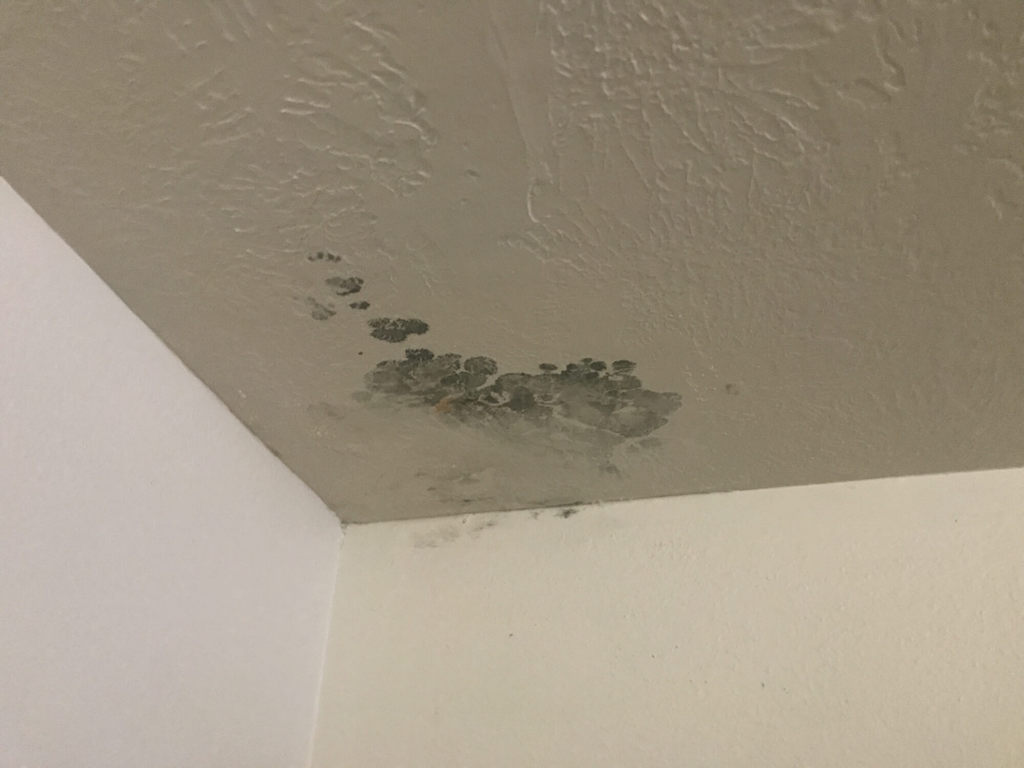
Again, the list goes on, which begs the question as to why mold in college dorms is such a big, and growing, issue. Turns out, there are a variety of reasons and they all boil down to moisture issues.
Humidity
The EPA states that mold can grow in environments where the humidity rises above 60 percent and suggests residents keep the indoor level between 30-50 percent. The lower, the better so as to avoid this tenacious fungus. ¹⁵
Dorms aren’t exactly known for dry air. Let’s face it, most of the time when you walk into these buildings, they have that oppressive wet, heavy air feel and a funky smell. Between the constant running water, flushing toilets, poor ventilation systems, and cramped spaces filled with wet towels, clothes, and other random items, moisture abounds in these spaces.
Constant high humidity in these spaces opens the door wide open for mold growth, especially if there are rapid temperature changes that lead to condensation. Any form of pooled water is a mold spore’s dream.
Poor Infrastructure
Many campuses boast about their long and rich history of educating the next generation, but a mature campus typically means old buildings. Older structures can host a myriad of problems, from outdated air conditioning and HVAC systems, improperly fixed issues, and aged foundations. All of which can allow moisture to remain in the building, create wet problems, or permit outside moisture to make its way inside. More moisture means more moldy opportunities.
On the other hand, some buildings, new and old, are built in a way that supports moisture retention and high humidity levels. This could include bad insulation, poor ventilation, improper HVAC systems, foundation problems, and more. All of these can collectively lead to water finding its way into the building, high humidity levels, water retention, and moisture creation. Which, as we now know, creates the perfect conditions for mold in college dorms to occur.
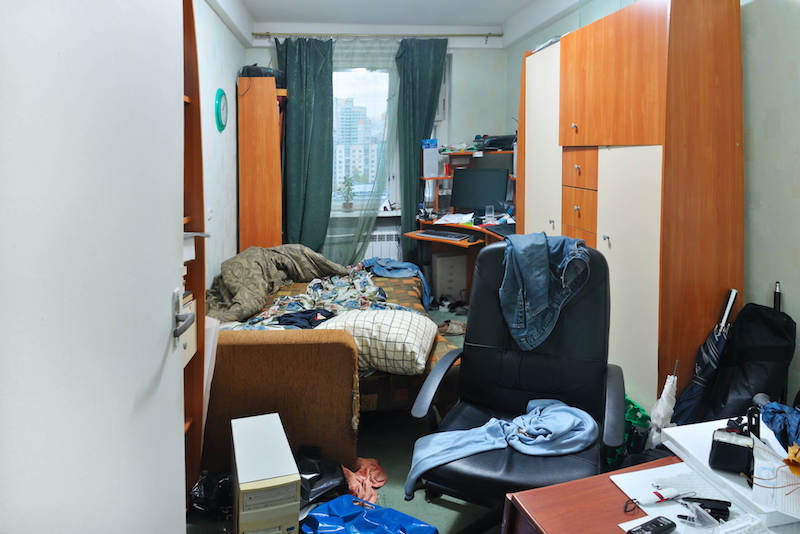
Lack of Cleanliness
This is a two-part problem.
College students aren’t known for their stellar cleanliness. Chances are that if you go into a dorm, the bathroom is pretty sketchy and the room is filled with… who knows what. Not keeping up with a cleaning schedule allows moisture to develop, either from wet clothing and towels, spills, damp umbrellas, or bathroom disasters. Again, moisture equals mold growth potential. Lack of cleaning also leaves behind all of the yummy food idioms living mold likes to munch on. From dust and to crumbs and random organic particles, there will be a full buffet of items for this fungus.
On the other hand, many colleges employ individuals to clean common areas like the bathroom. Issues can arise if these areas aren’t cleaned enough, deep cleaning rarely occurs, areas like the exhaust fans or other ventilation units aren’t regularly taken care of, or improper cleaning products and protocols are used to take care of any small mold spots. Also, failing to regularly clean small air conditioning units, if they are installed in dorm rooms. All of which can allow mold in college dorms to occur.
Improper Maintenance
Older buildings, in particular, have this issue, but newer student residences can also fall into this category.
Improper maintenance can include:
- Not keeping up with the HVAC system so that it’s clean, moisture-free, and operating correctly.
- Failure to regularly change air filters, or choose ones that adequately filter out mold particles.
- Lack of cleaning in the building as a whole.
- Neglecting to hire inspectors to ensure all systems are working properly and the indoor air quality is safe.
- Not outfitting the building so as to avoid water intrusion and buildup or checking that these measures are functioning properly.
- Failing to check water-prone areas, like the roof, for leaks or weak areas that could lead to problems.
These are just a few points schools may be missing to avoid mold in college dorms. Not keeping up with building maintenance can easily lead to mold growth.
Leaks
One of the biggest issues college dorms face is leaks. Whether pipes, faucets, toilets, windows, or roofing, there are a million ways for water to make its way uninvited inside of these buildings. When the college doesn’t address these problems promptly, they can easily lead to mold growth. Oftentimes, these can be the areas that go undetected for some time before anyone discovers a problem. The growth could be occurring in the ceiling, inside the wall, under the carpet, or in the basement, which leads to an increasing number of mold spores in the air. Toxin and bacterial presence are also potential contamination issues as well.
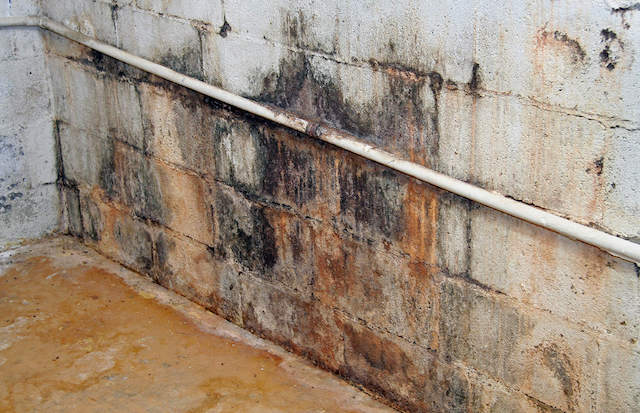
Mold growth can also occur if these leaky disasters aren’t dealt with properly. Not taking care of the entire wet area from a leaky roof, using protocols to ensure mold doesn’t have the opportunity to grow, or calling an air quality professional if necessary can lead to serious problems.
Avoiding Mold in College Dorms
The potential problematic areas listed above are a few examples of how mold in college dorms can occur, but there are various other ways it can sneak in. Preventative measures both by the students and university are the best ways to ensure this fungus stays out of their living spaces. That way, students can focus on cramming for tests and making it to class on time.
Tips for Students to Prevent Mold in College Dorms
Students are usually focused on classes and their social lives, but adding a few things to their daily and weekly routines can help prevent mold from sneaking its way inside their living spaces.
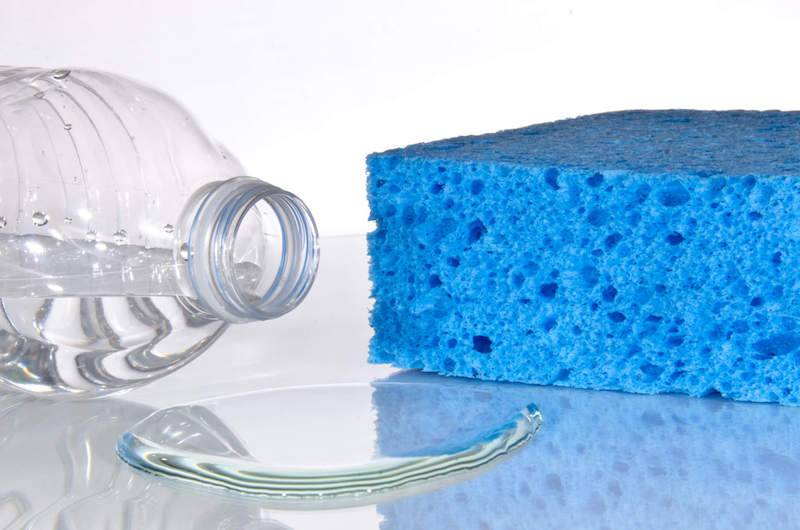
These steps include:
- Creating daily and deep cleaning schedules and sticking to them
- Wipe up any spills asap.
- Don’t let wet clothing, towels, or umbrellas just sit around.
- Turn on the exhaust fans while showering.
- Get an air purifier to regularly remove particles from the indoor air.
- If it’s humid in the building, place a dehumidifier in their room to remove moisture from the air.
- Check for any leaks at least once a month.
- If there’s a thermostat in the room, don’t frequently fluctuate the temperature (it can lead to condensation)
- Don’t block airflow
This isn’t an exhaustive list, but it’s a great start to help ensure you or your child is actively working towards creating a healthier and safer indoor space. From there, it’s up to the campus to mitigate moldy opportunities.
Also, make sure to check the room over thoroughly when moving in to make sure there’s no mold and you or your child is starting off with a clean slate. This includes looking for visible mold, coffee-like stains in the ceiling, checking any air vents, and taking a deep breath to see if there is a musty smell.
Tips for Colleges to Prevent Mold in College Dorms
If you’re a college student or parent, always make sure that the campus is actively taking steps to avoid mold growth. They should understand exactly how important it is for the health of their students and have a plan of action in place as well as experts to consult to make sure they’re doing everything they can to ensure that there’s no mold in college dorms.
These actions can include:
- Fix any leaks immediately and properly.
- Regularly check for any leaks or weak spots in the building that could lead to moldy problems.
- Keep humidity levels low (30-50 degrees).
- Maintain the HVAC system-this includes changing parts like the air filter as directed, keeping it clean, and regularly hiring an inspector to make sure it’s running properly.
- Ensure there’s adequate ventilation in the building.
- Educate students on how they can help prevent mold growth.
- Update outdated systems and building components, like the HVAC, plumbing, and roofing, so they don’t malfunction or break down and cause massive water events

There are other actions college campuses can take to help prevent mold in college dorms, but these steps are a good start. Not only can prevention keep students safe, but it also saves money in the long run from remediation, rehousing, and potential lawsuits.
So… Did You Discover Mold in College Dorms?
If you or your child discovers mold, report it immediately to the school. They should have a plan in place, crafted by consultations with experts, to handle the problem. Similarly, if you’re employed by the university and find mold, report it immediately to the department in charge of handling moldy situations.
Mold growth should be handled quickly so as to avoid any health issues from poor air quality and exposure as well as to prevent further spread in the building. The key here is to address the problem correctly and not look for a quick fix. That’s just asking for problems and more than likely, will not get rid of the mold.
If mold growth is discovered, the university should hire a qualified mold inspector to come in and assess the problem. They could be dealing with just that small area of mold growth, or they could be looking at a more widescale problem. Additionally, with how easily mold spores and toxins move invisibly throughout the air, the contamination level could have made it to the other dorm rooms nearby. All of which qualify as exposure and could cause adverse health reactions in students.
The mold inspector should use a variety of measuring techniques, assess if there are other problematic areas, and determine what the contamination level is in the dorm. This includes the volume of mold spores present, species of mold, and presence of mycotoxins and bacteria. The data they collect will give the college the information they need to determine what the next steps are. Is it a problem they can handle, or does a remediation team need to come in?

From there, they should have two courses of action planned out. Both of which should be formed by experts!
If the mold can be handled by the college, they should understand how to properly remove the mold and decontaminate the area. A few points to keep in mind here are that killing mold is not the answer. It needs to be removed by the roots, otherwise, exposure will continue, and/or the mold could grow back. Also, mycotoxins and bacteria cannot be cleaned and removed the same way that mold can. It takes a more extensive process. Student belongings will also need to be properly sanitized to remove any mold particles and byproducts. An expert will be able to give them a completed list of exactly what needs to be done to handle the mold issue correctly.
If the college needs to hire a remediation company, they should know that not all remediation companies are built the same. The team they go with should be able to handle the issue properly and thoroughly so the students are safe to return. A quick and easy test is to see if they stand on these three pillars.
- Remediate the sources and mold properly
- Identify and address the problems that led to the sources in the first place (otherwise, the mold will just grow back)
- Eradicate all contamination that exists from the mold problem, including mycotoxins and bacteria
Failure to hit those points means the remediation was not successful and students could continue to suffer.
For students and parents, stay up to date on exactly what colleges are doing to address mold problems. They should be giving you a play-by-play of their decisions and actions to handle the mold growth and ensure that they’re creating safe and healthy indoor living spaces. If you’re concerned they’re not going about the mold removal the right way, contact an expert for their opinion.
Having a Mold-Free College Experience
The college experience is a huge part of many people’s lives. While it’s enormously stressful and filled with a rollercoaster of ups and downs, it’s the place where you get to find yourself, develop your passions, challenge your world views, and meet people from all over. Mold can put a bit of a kink in that experience, though.

Most students and parents probably don’t think about adding mold to their checklist, but it should absolutely be on there! From keeping an eye out for it, preventing it in the dorm room, and knowing what steps to take if it’s found, maintaining mold awareness can help ensure college students are healthy and spending their time focusing on what matters. Starting the next chapter of their lives.
Citations:
- Environmental Protection Agency. (n.d.). Mold. EPA. Retrieved August 17, 2021, from https://www.epa.gov/mold.
- Centers for Disease Control and Prevention. (2020, August 11). Basic facts about mold and dampness. Centers for Disease Control and Prevention. Retrieved August 17, 2021, from https://www.cdc.gov/mold/faqs.htm.
- Lstiburek, J., Brennan, T., & Yost, N. (2002, January 15). Rr-0208: What you need to know about mold. Building Science Corporation. Retrieved August 18, 2021, from https://www.buildingscience.com/documents/reports/rr-0208-what-you-need-to-know-about-mold/view.
- World Health Organization. (n.d.). Mycotoxins. World Health Organization. Retrieved August 26, 2021, from https://www.who.int/news-room/fact-sheets/detail/mycotoxins.
- Bush, R. K., Portnoy, J. M., Saxon, A., Terr, A. I., & Wood, R. A. (2006). The medical effects of mold exposure. Journal of Allergy and Clinical Immunology, 117(2), 326-333
- Environmental and Occupational Health Assessment Program, & Environmental and Occupational Health Assessment Program, & Health Science Section, Mold Basics for Primary Care Clinicians (2009). Hartford, CT; Connecticut Department of Public Health. , H. S. S., Mold Basics for Primary Care Clinicians 1–10 (2009). Hartford, CT; Connecticut Department of Public Health.
- Curtis, L., Lieberman, A., Stark, M., Rea, W., & Vetter, M. (2004). Adverse health effects of indoor molds. Journal of Nutritional & Environmental Medicine, 14(3), 261-274.
- EPA. (2008, September). Mold remediation in schools and commercial buildings. Environmental Protection Agency. Retrieved November 4, 2021, from https://beta.epa.gov/sites/default/files/2014-08/documents/moldremediation.pdf.
- Eaglin, M., & Hampton, D. (2021, October 26). Howard University students protest mold, rodents in campus dorms. NBCNews.com. Retrieved November 4, 2021, from https://www.nbcnews.com/news/nbcblk/howard-university-students-protest-mold-rodents-campus-dorms-rcna3709.
- James-Rodil, A. (2021, October 14). East Wheelock mold exposure prompts students to relocate as college begins short-term remediation efforts. The Dartmouth. Retrieved November 4, 2021, from https://www.thedartmouth.com/article/2021/10/east-wheelock-mold-exposure-prompts-students-to-relocate-as-college-begins-short-term-remediation-efforts.
- Jun, H. (2019, August 25). When college dormitories become health hazards. The New York Times. Retrieved November 4, 2021, from https://www.nytimes.com/2019/08/25/us/college-dorms-mold-health.html.
- Davis, L., & Honker, C. (2019, October 8). Leslie Davis and Carmen Honker. Flat Hat News. Retrieved November 4, 2021, from https://flathatnews.com/2019/10/08/students-report-health-complications-from-mold-exposure-in-campus-housing/.
- Richman, T. (2019, October 4). University of Maryland professors say mold in campus building is making them sick. The Baltimore Sun. Retrieved November 4, 2021, from https://www.baltimoresun.com/education/bs-md-umd-mold-2019.
- CBS Interactive. (2018, November 27). Parents of Maryland Student who died say health center didn't test for adenovirus. CBS News. Retrieved November 4, 2021, from https://www.cbsnews.com/news/adenovirus-death-university-maryland-student-olivia-paregol-parents-speak-out-mold-health-center/.
- EPA. (n.d.). Mold Course Chapter 2: Why and Where Mold Grows. EPA. Retrieved November 4, 2021, from https://www.epa.gov/mold/mold-course-chapter-2#Chapter2Lesson3.

